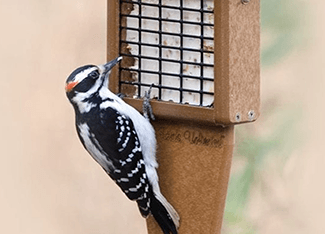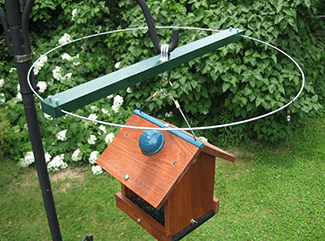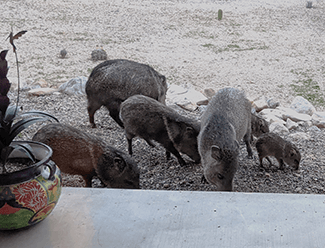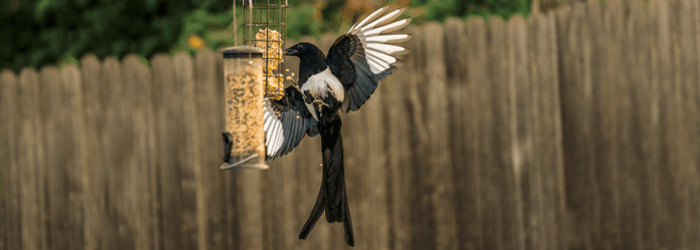Arizona boasts a bounty bird species, some that can been seen year-round and other that visit in the winter as they migrate from colder areas of the country.
With the help of Jon Friedman with the Friedman Family’s Wild Bird Store in Tucson, let’s explore the food that will attract a variety of birds to your yard.
Food Types
Most species have their food preferences. Some, like the goldfinches, prefer Nyjer thistle seed and will neglect almost everything else. Cardinals will eat a wider variety of seeds besides their preferred sunflower and safflower seeds. In fact, the cardinal family (Northern Cardinal, Pyrrhuloxia, and the grosbeaks) will also frequent suet feeders, feeders for peanuts and/or tree nuts, fruit feeders, kibble feeders, and feeders for live or dehydrated insects and feeders filled with our insect meal (Nuts ‘n’ Bugs.)
Suet Cake
 Suet cake allows birds to peck at a solid chunk of food. Suet is raw beef fat that is mixed with bird seeds, dried bugs, and other favorite bird foods. Use suet in the cooler months, it will melt into a nasty mess in the summer that could attract bugs you may not want.
Suet cake allows birds to peck at a solid chunk of food. Suet is raw beef fat that is mixed with bird seeds, dried bugs, and other favorite bird foods. Use suet in the cooler months, it will melt into a nasty mess in the summer that could attract bugs you may not want.
Fresh Seed
Birds love fresh seeds. Use a high-quality recipe featuring fresh small black oil sunflower, safflower, canary, and millet seeds. You can fill two or three seed feeders with individual seeds to attract seed eaters with distinguished feeding preferences or not to tolerate other species at their feeder.
Jon suggests buying blends without added grains. He says that grains are usually used in almost all commercial mixes as it adds bulk and weight to the bag at a lower cost than all seed mixes. They use commonly grains (usually milo, wheat berries, cracked corn, and various types of oats). They are priced cheaply because they only contain a small percentage of actual seed that birds prefer while the inexpensive grains will drop onto the ground. He notes that the cheaper the mix, the more filler and bulk they contain. The cheapest of these economy mixes may even contain a fair amount of grain, dust, dirt and small pebbles and plant by-products, all of which are inedible, but add to the weight and bulk of the bag. For a more complete explanation of why certain seeds and mixes are preferred over low-cost grain mixes see this his article, Myths and Facts Concerning Feeding Wild Birds.
Nyjer Thistle
Nyjer thistle feeders attract the migratory Lawrence’s and American Goldfinches, and the Pine Siskins, in addition to the two Lesser Goldfinches that are year round residents.
Cardinal Mix
You won’t see any football players at your feeder, but species-specific cardinal feeders can attract Northern Cardinal and Pyrrhuloxia and sometimes Black-headed, Blue, and Rose-breasted Grosbeaks. Buy a Cardinal Mix composed of small black oil sunflower seeds, safflower seed, large black-striped sunflower seeds, sunflower hearts, hemp seed, and peanut kernels.
Bird Types
Sparrows
 To attract some of the rarest sparrow species, you may have to visit them in their natural habitats. However, you can attract many species to your yard with dove-proof ground platform feeders or scattering the right seeds directly on the ground. Jon says that sparrows are ground-feeding birds. Magic Halos will prevent sparrows from using any given elevated feeder or the ground beneath the feeder.
To attract some of the rarest sparrow species, you may have to visit them in their natural habitats. However, you can attract many species to your yard with dove-proof ground platform feeders or scattering the right seeds directly on the ground. Jon says that sparrows are ground-feeding birds. Magic Halos will prevent sparrows from using any given elevated feeder or the ground beneath the feeder.
You may even attract exotic sparrow species such as Rufous-crowned and Rufous-winged, Cassin’s, Sage, Black-chinned, Brewer’s, Chipping, Baird’s, Grasshopper, Savannah, Vesper, Lark, White-throated, Fox and Slate-colored Fox, Song, Savannah, and Lincoln’s Sparrows.
Towhees & Juncos
Towhees and juncos are also part of the sparrow family. Towhees are natural ground feeding birds that will use ground and/or platform feeders. Jon finds that on the ground or in a platform feeder they will pick at a scratch mix but he finds they prefer real seeds, especially finch mix or white proso millet. They will also eat Nyjer thistle on the ground. Like all sparrows, the towhees and juncos prefer seeds in the winter and insects in the summer months.
Quail
Gambel’s Quail are easily attracted to grain and/or seed mixes and are known for eating a wide variety of fruits, especially berries. Various seed and/or grain mixes are compressed into dense blocks or cylinders and are a popular way to attract and feed quail
Roadrunners
Roadrunners rely primarily on prey they hunt, but they can be taught to feed out of our hands. Jon finds that those who hand-feed roadrunners usually use cooked hamburger meat or Nuts ‘n’ Bugs insect meal. You can even combine them.
Hummingbirds
Arizona boasts more species of hummingbirds than any other region of the country with the only possible exception being the much larger Texas/Mexico border. Buy a nectar from a wild bird store that is specifically formulated to attracting hummingbirds. It is considerably safer than simple sugar water that has to be replaced every day or so in the summer. An overripe banana placed near one of their feeders will attract generations of fruit flies and gnats that the hummingbirds will devour.
Woodpeckers, Flickers and Sapsuckers
This flock drills rows of holes, usually horizontal, in tree bark. They will return later to the drink sap and eat the insects that are attracted to the sap.
Insectivores and Cedar Waxwings
Titmice, chickadees, nuthatches, creepers, and most wren species will be attracted to nuts, sunflower hearts, non-melt suets, and gorp (homemade peanut butter mixtures). All these same species are easily attracted to Nuts ‘n’ Bugs insect meal. It can be pushed into the textured bark of trees or used in an appropriate feeder. Mockingbirds and thrashers can be attracted using fruits, Nuts ‘n’ Bugs, some suet flavors, and nuts of various kinds. Kinglets will eat similar foods. Cedar Waxwings are attracted berries including pyracantha and grape ivy berries. They can be attracted to your feeding station using plumped raisins and/or currents, apple slices, and canned peas.
Warblers
Most warblers can be attracted to Nuts ‘n’ Bugs, non-melt suet, gorp, and even nectar. However, water is the best attraction for most species of warblers, especially activated water such as artificial streams, fountains, and bird baths with wigglers, drippers or misters attached to them.

Other Considerations
Some municipalities have banned feeding wild birds. Check with your city or town before putting out any food.
Be aware that javelina love bird seed. So, if you sprinkle seed on the ground and you live in area known for javelina, take caution when going outside. The babies may look like adorable fuzzy footballs with feet, but their mama will attack if she feels threatened.
If you prefer not setting out seeds and suet, check out our guide, native plants that will attract a bounty of birds.
###
PODCAST
Audubon Arizona Director Of Bird Conservation Tice Supplee joins us for our Weekly To Do on attracting and feeding a bounty of year round and visiting bird species. Plus homeowners have questions on removing a sunken living room, sound proofing, removing existing wallpaper and more!
Podcast Archive With Expanded Content and Resources
PHOTO CREDIT
- Wild Birds Unlimited
- Shutterstock
















